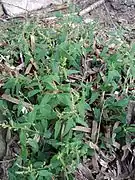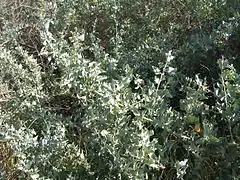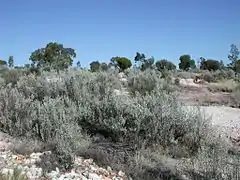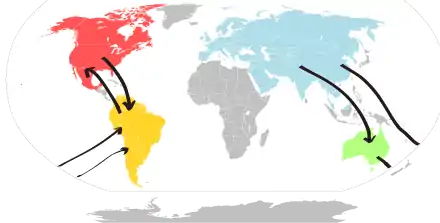Atriplex
Atriplex (/ˈætrɪplɛks/[1]) is a plant genus of 250–300 species, known by the common names of saltbush and orache (/ˈɒrətʃ/;[2] also spelled orach). It belongs to the subfamily Chenopodioideae of the family Amaranthaceae s.l.. The genus is quite variable and widely distributed. It includes many desert and seashore plants and halophytes, as well as plants of moist environments. The generic name originated in Latin and was applied by Pliny the Elder to the edible oraches.[3] The name saltbush derives from the fact that the plants retain salt in their leaves; they are able to grow in areas affected by soil salination.
| Atriplex | |
|---|---|
 | |
| Garden orache (Atriplex hortensis) From Sturm & Sturm (1796): Deutschlands Flora in Abbildungen. | |
| Scientific classification | |
| Kingdom: | Plantae |
| Clade: | Tracheophytes |
| Clade: | Angiosperms |
| Clade: | Eudicots |
| Order: | Caryophyllales |
| Family: | Amaranthaceae |
| Subfamily: | Chenopodioideae |
| Tribe: | Atripliceae |
| Genus: | Atriplex L. |
| Type species | |
| Atriplex hortensis L. | |
| Species | |
|
About 250-300, see text | |
| Synonyms | |
|
Blackiella Aellen | |
Description
.jpg.webp)
The species in genus Atriplex are annual or perennial herbs, subshrubs, or shrubs. The plants are often covered with bladderlike hairs, that later collapse and form a silvery, scurfy or mealy surface, rarely with elongate trichomes. The alternate or rarely opposite leaves are petiolate or sessile, often persistent or tardily deciduous. The flat or slightly fleshy leaf blades are either entire, or serrate, or lobed and very variable in shape.[4][5]
The inflorescences consist of axillary or terminal spikes or spicate panicles, or axillary clusters of glomeruled flowers. The flowers are unisexual, some species are monoecious, others dioecious. Male flowers consist of 3-5 perianth lobes and 3-5 stamens. Female flowers are usually lacking a perianth, but are enclosed by 2 foliaceous bracteoles, and contain an ovary with a short style and 2 stigmas.[4][5]
In fruit, the bracteoles can enlarge, thicken or become appendaged. They enclose the fruit tightly, without becoming connate to it. The pericarp is adnate to the vertically orientated, flattened seed. The seed coat is thick, leathery or hardening. The annular embryo surrounds the perisperm.[4][5]
The chromosome base number is x = 9, except for Atriplex lanfrancoi, which is x=10.[6]
A few Atriplex species are C3-plants, but most species are C4-plants, with a characteristic leaf anatomy (kranz anatomy).[6]
Distribution and evolution
The genus Atriplex is distributed nearly worldwide from subtropical to temperate and to subarctic regions. Most species-rich are Australia, North America, South America and Eurasia. Many species are halophytes and are adapted to dry environments with salty soils.[6]
The genus evolved in Middle Miocene, the C4-photosynthesis pathway developed about 14.1-10.9 million years ago, when the climate became increasingly dry. The genus diversified rapidly and spread over the continents. The C4Atriplex colonized North America probably from Eurasia during the Middle/Late Miocene, about 9.8-8.8 million years ago, and later spread to South America. Australia was colonized twice by two C4 lineages, one from Eurasia or America about 9.8-7.8 million years ago, and one from Central Asia about 6.3-4.8 million years ago. The last lineage diversified rapidly, and became the ancestor of most Australian Atriplex species.[6]
Ecology
Atriplex species are used as food plants by the larvae of some Lepidoptera species; see the list of Lepidoptera which feed on Atriplex.[7] For spiders such as Phidippus californicus and other arthropods, saltbush plants offer opportunities to hide and hunt in habitat that is otherwise often quite barren.
It has been proposed that genus Atriplex was a main food source in the diet of the extinct giant kangaroo Procoptodon goliah.[8] Stable isotopic data suggested that their diet consisted of plants that used the C4 photosynthetic pathway, and due to their semi-arid distribution, chenopod saltbushes were likely responsible.[9][10][11]
Use by humans
The favored species for human consumption is now usually garden orache (A. hortensis),[12][13][14] but many species are edible and the use of Atriplex as food is known since at least the late Epipaleolithic (Mesolithic).
Common orache (A. patula) is attested as an archaeophyte in northern Europe, and the Ertebølle culture is presumed to have used it as a food.[15] Its seed has been found among apparent evidence of cereal preparation and cooking at Late Iron Age villages in Britain.[16] In the biblical Book of Job, mallûaḥ (מַלּ֣וּחַ, probably Mediterranean saltbush, A. halimus, the major culinary saltbush in the region) is mentioned as food eaten by social outcasts (Job 30:4[17]). Grey saltbush (A. cinerea) has been used as bushfood in Australia since prehistoric times. Chamiso (A. canescens) and shadscale (A. confertifolia) were eaten by Native Americans, and spearscale (A. hastata) was a food in rural Eurasia.
Studies on Atriplex species demonstrated their potential use in agriculture. Meat from sheep which have grazed on saltbush has surprisingly high levels of vitamin E, is leaner and more hydrated than regular lamb and has consumer appeal equal to grain-fed lamb.[18] The vitamin E levels could have animal health benefits while extending the shelf-life and maintaining the fresh red colour of saltbush lamb. This effect has been demonstrated for old man saltbush (A. nummularia) and river saltbush (A. amnicola). For reasons unknown, sheep seem to prefer the more fibrous, less nutritious river saltbush.[19][18]
A study on Atriplex nummularia discovered the species have a nitrogen content of 2.5-3.5%, and could potentially be used as a protein supplement for grazing if palatable.[20] A subsequent study allowed sheep and goats to voluntarily feed on Atriplex halimus and aimed to determine if the saltbush was palatable, and if so, did it provide enough nutrients to supplement the diet of these animals.[21] In this study they determined when goats and sheep are given as much A. halimus as they like, they do obtain enough nutrients to supplement their diet – unless the animal requirements are higher during pregnancy and milk production.
Saltbushes are also used as an ornamental plant in landscaping and can be used to prevent soil erosion in coastal areas.[22][23] Old man saltbush (Atriplex nummularia) has also been successfully used to rehabilitate old mining sites around Lightning Ridge (Australia).
 Atriplex elegans
Atriplex elegans Atriplex hymenelytra
Atriplex hymenelytra Atriplex latifolia
Atriplex latifolia Atriplex lentiformis
Atriplex lentiformis Atriplex nummularia
Atriplex nummularia Atriplex suberecta
Atriplex suberecta
Systematics
The genus Atriplex was first described in 1753 by Carl Linnaeus.[24] The type species (lectotype) is Atriplex hortensis.[25] The name is derived from Ancient Greek ἀτράφαξυς (atraphaxys), "orach", itself a Pre-Greek substrate loanword.
Atriplex is an extremely species-rich genus and comprises about 250[5]-300[6] species.
Traditional taxonomy of Atripliceae based on morphological features has been controversial.[26] Molecular studies have found that many genera are not true clades. One such study found that Atripliceae could be divided into two main clades, Archiatriplex, with a few, scattered species, and the larger Atriplex clade, which is highly diverse and found around the world.[26] After phylogenetical research, Kadereit et al. (2010) excluded Halimione as a distinct sister genus. The remaining Atriplex species were grouped into several clades.[6]
The following is a cladogram with estimated divergence times for the tribe Atripliceae. To infer the phylogeny, an ITS matrix composed of spacer ITS-1, the 5.8S subunit, and spacer ITS-2 were amplified and sequenced for each specimen. Not all species in the genus Atriplex are presented in the cladogram. Cladogram based on page 7 of Origin and evolution of Atriplex (Amaranthaceaes.l.) in the Americas: Unexpected insights from South American species. (2019).[27] This paper provided new hypothesis suggesting The Americas were colonised by C4 Atriplex from Eurasia or Australia. Further, Atriplex originated in South America, where two lineages underwent in situ diversification and evolved sympatrically. North America was then colonised by Atriplex from South America. Then later one lineage moved back to South America.[27]
Cladogram of estimated divergences within the genus Atriplex | ||||||||||||||||||||||||||||||||||||||||||||||||||||||||||||||||||||||||||||||||||||||||||||||||||||||||||||||||||||||||||||||||||||||||||||||||||||||||||||||||||||||||||||||||||||||||||||||||||||||||||||||||||||||||||||||||||||||||||||||||||||||||||||||||||||||||||||||||||||||||||||||||||||||||||||||||||||||||||||||||||||||||||||||||||||||||||||||||||||||||||||||||||||||||||||||||||||||||||||||||||||||||||||||||||||||||||||||||||||||||||||||||||||||||||||||||||||||||||||||||||||||||||||||||||||||||||||||||||||||||||||||||||||||||||||||||||||||||||||||||||||
|---|---|---|---|---|---|---|---|---|---|---|---|---|---|---|---|---|---|---|---|---|---|---|---|---|---|---|---|---|---|---|---|---|---|---|---|---|---|---|---|---|---|---|---|---|---|---|---|---|---|---|---|---|---|---|---|---|---|---|---|---|---|---|---|---|---|---|---|---|---|---|---|---|---|---|---|---|---|---|---|---|---|---|---|---|---|---|---|---|---|---|---|---|---|---|---|---|---|---|---|---|---|---|---|---|---|---|---|---|---|---|---|---|---|---|---|---|---|---|---|---|---|---|---|---|---|---|---|---|---|---|---|---|---|---|---|---|---|---|---|---|---|---|---|---|---|---|---|---|---|---|---|---|---|---|---|---|---|---|---|---|---|---|---|---|---|---|---|---|---|---|---|---|---|---|---|---|---|---|---|---|---|---|---|---|---|---|---|---|---|---|---|---|---|---|---|---|---|---|---|---|---|---|---|---|---|---|---|---|---|---|---|---|---|---|---|---|---|---|---|---|---|---|---|---|---|---|---|---|---|---|---|---|---|---|---|---|---|---|---|---|---|---|---|---|---|---|---|---|---|---|---|---|---|---|---|---|---|---|---|---|---|---|---|---|---|---|---|---|---|---|---|---|---|---|---|---|---|---|---|---|---|---|---|---|---|---|---|---|---|---|---|---|---|---|---|---|---|---|---|---|---|---|---|---|---|---|---|---|---|---|---|---|---|---|---|---|---|---|---|---|---|---|---|---|---|---|---|---|---|---|---|---|---|---|---|---|---|---|---|---|---|---|---|---|---|---|---|---|---|---|---|---|---|---|---|---|---|---|---|---|---|---|---|---|---|---|---|---|---|---|---|---|---|---|---|---|---|---|---|---|---|---|---|---|---|---|---|---|---|---|---|---|---|---|---|---|---|---|---|---|---|---|---|---|---|---|---|---|---|---|---|---|---|---|---|---|---|---|---|---|---|---|---|---|---|---|---|---|---|---|---|---|---|---|---|---|---|---|---|---|---|---|---|---|---|---|---|---|---|---|---|---|---|---|---|---|---|---|---|---|---|---|---|---|---|---|---|---|---|---|---|---|---|---|---|---|---|---|---|---|---|---|---|---|---|---|---|---|---|---|---|---|---|---|---|---|---|---|---|---|---|---|---|---|---|---|---|---|---|---|---|---|---|---|---|---|---|---|---|---|---|---|---|---|---|---|---|---|---|---|---|---|---|---|---|---|---|---|---|---|---|---|---|---|---|---|---|---|---|---|---|---|---|---|---|---|---|---|---|---|---|---|---|---|

Background colour in cladogram represents the region where a species is endemic.
South America
North America
Australia
Eurasia  Brignone et al. (2019) hypothesis for the evolution and movement of Atriplex species globally.[27]
|
Clades of Atriplex |
|---|
|
Selected species not yet investigated phylogenetically:
|
|
Excluded species:
- Extriplex:[29]
- Extriplex californica (Moq.) E.H.Zacharias (Syn. Atriplex californica Moq.)
- Extriplex joaquinana (A.Nelson) E.H.Zacharias (Syn. Atriplex joaquiniana A.Nelson)
- Halimione Aellen:[6]
- Halimione pedunculata (L.) Aellen (Syn.: Atriplex pedunculata L.)
- Halimione portulacoides (L.) Aellen (Syn.: Atriplex portulacoides L.)
- Halimione verrucifera (M.Bieb.) Aellen (Syn.: Atriplex verrucifera M.Bieb.)
- Stutzia E.H.Zacharias:[29]
- Stutzia covillei (Standl.) E. H. Zacharias (Syn. Atriplex covillei (Standl.) J. F. Macbr.)
- Stutzia dioica (Nutt.) E. H. Zacharias (Syn. Atriplex suckleyi (Torrey) Rydberg, Atriplex ovata (Rydb.) Clem. & E. G. Clem.)
References
- Sunset Western Garden Book, 1995:606–607
- "orache". Oxford English Dictionary third edition. Oxford University Press. June 2004. Retrieved 7 December 2018.
- Quattrocchi, Umberto (2000). CRC World Dictionary of Plant Names. I: A-C. CRC Press. p. 232. ISBN 978-0-8493-2675-2.
- Stanley L. Welsh: Atriplex - online, In: Flora of North America Editorial Committee (ed.): Flora of North America North of Mexico, Volume 4: Magnoliophyta: Caryophyllidae, part 1., Oxford University Press, New York. 2003, ISBN 0-19-517389-9.
- Gelin Zhu, Sergei L. Mosyakin & Steven E. Clemants: Chenopodiaceae: Atriplex - online, In: Wu Zhengyi, Peter H. Raven, Deyuan Hong (ed.): Flora of China, Volume 5: Ulmaceae through Basellaceae., Science Press und Missouri Botanical Garden Press, Beijing und St. Louis, 2003, ISBN 1-930723-27-X.
- Gudrun Kadereit, Evgeny V. Mavrodiev, Elizabeth H. Zacharias & Alexander P. Sukhorukov: Molecular phylogeny of Atripliceae (Chenopodioideae, Chenopodiaceae): Implications for systematics, biogeography, flower and fruit evolution, and the origin of C4 Photosynthesis. - American Journal of Botany 97(10): 1664-1687, 2010.
- "HOSTS - The Hostplants and Caterpillars Database at the Natural History Museum". www.nhm.ac.uk. Retrieved 2020-09-28.
- Prideaux, Gavin J.; Ayliffe, Linda K.; DeSantis, Larisa R. G.; Schubert, Blaine W.; Murray, Peter F.; Gagan, Michael K.; Cerling, Thure E. (2009-07-14). "Extinction implications of a chenopod browse diet for a giant Pleistocene kangaroo". Proceedings of the National Academy of Sciences. 106 (28): 11646–11650. Bibcode:2009PNAS..10611646P. doi:10.1073/pnas.0900956106. ISSN 0027-8424. PMC 2710660. PMID 19556539. S2CID 19904871.
- Kadereit, Gudrun; Mavrodiev, Evgeny V.; Zacharias, Elizabeth H.; Sukhorukov, Alexander P. (2010). "Molecular phylogeny of Atripliceae (Chenopodioideae, Chenopodiaceae): Implications for systematics, biogeography, flower and fruit evolution, and the origin of C4 photosynthesis". American Journal of Botany. 97 (10): 1664–1687. doi:10.3732/ajb.1000169. ISSN 1537-2197. PMID 21616801.
- Prideaux, G. (2004). "Systematics and Evolution of the Sthenurine Kangaroos". . UC Publications in Geological Sciences. University of California Press. doi:10.1525/california/9780520098459.001.0001. ISBN 9780520098459.
- DeSantis, Larisa R. G.; Field, Judith H.; Wroe, Stephen; Dodson, John R. (May 2017). "Dietary responses of Sahul (Pleistocene Australia–New Guinea) megafauna to climate and environmental change". Paleobiology. 43 (2): 181–195. doi:10.1017/pab.2016.50. ISSN 0094-8373. S2CID 13134989.
- "Orach facts and health benefits". Retrieved 2020-09-28.
- "Atriplex hortensis Orach, Garden orache PFAF Plant Database". pfaf.org. Retrieved 2020-09-28.
- "Atriplex hortensis (garden orache)". www.cabi.org. Retrieved 2020-09-28.
- Koch, Eva (December 1999). "Prehistoric plant food of Denmark". Archived from the original on 2006-07-17.
- Christopher Evans (2015), North West Cambridge Archaeology: University of Cambridge 2013 Excavations, The Traveller's Rest Sub-site (PDF), Cambridge Archaeological Unit University Of Cambridge, pp. 100–113
- Mistranslated as "mallows" in the King James Bible and as Nesseln (nettles) in the Luther Bible
- Pearce, Kelly & Jacob, Robin (2004): Saltbush lifts sheep meat vitamin content. Farming Ahead 153(October): 63. PDF fulltext Archived July 23, 2005, at the Wayback Machine
- Norman, Hayley C.; Freind, Colby; Masters, David G.; Rintoul, Allan J.; Dynes, Robyn A. & Williams, Ian H. (2004): Variation within and between two saltbush species in plant composition and subsequent selection by sheep. Aust. J. Agr. Res. 55(9): 999–1007. doi:10.1071/AR04031 (HTML abstract)
- Wilson, A.D., Harrington, G.N. (1980). "Nutritive value of Australian browse plants". International Livestock Centre for Africa. Addis Ababa: 291.CS1 maint: multiple names: authors list (link)
- Valderrabano, J., Munoz, F., Delgado, I. (1996). "Browsing ability and utilisation by sheep and goats of Atriplex hamilus L. shrubs". Small Ruminant Research. Zaragoza, Spain. 19 (2): 131–136. doi:10.1016/0921-4488(95)00754-7. Retrieved 13 April 2020.CS1 maint: multiple names: authors list (link)
- "Saltbushes for dryland salinity management in Western Australia". www.agric.wa.gov.au. Retrieved 2020-09-28.
- "Atriplex semibaccata (Australian saltbush)". www.cabi.org. Retrieved 2020-09-28.
- Carl Linnaeus (1753), "Atriplex", Species Plantarum, 2, Lars Salvius/Biodiversity Heritage Library, pp. 1052–1054, retrieved 19 May 2015
- Atriplex at Tropicos, accessed 2013-07-11
- Flores, Hilda; Davis, Jerrold I. (2001). "A Cladistic Analysis of Atripliceae (Chenopodiaceae) Based on Morphological Data". Journal of the Torrey Botanical Society. 128 (3): 297. doi:10.2307/3088719. JSTOR 3088719.
- Brignone, Nicolás F.; Pozner, Raúl E.; Denham, Silvia S. (October 2019). "Origin and evolution of Atriplex (Amaranthaceae s.l.) in the Americas: Unexpected insights from South American species". International Association for Plant Taxonomy. 68 (5): 1027. doi:10.1002/tax.12133.
- Tasmanian name, also transcribed trucanini, trucaninny, trugannini, trugernanna, etc. The plant was the namesake for Truganini, among the last of her people.
- Elizabeth H. Zacharias, Bruce G. Baldwin (2010): A Molecular Phylogeny of North American Atripliceae (Chenopodiaceae), with Implications for Floral and Photosynthetic Pathway Evolution. In: Systematic Botany 35(4), p.839-857. doi:10.1600/036364410X539907
